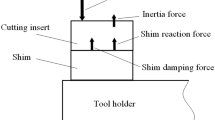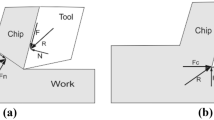Abstract
In the process of high-efficient milling titanium alloy(Ti6Al4V) workpieces, the ICS (instantaneous contact stiffness) and its distribution between flank face of milling cutter tooth and workpiece change instantaneously due to cutting vibration, which makes tool flank friction and wear status be of instability. In this work, the tool flank micro-convex body stiffness model was developed considering the influence of cutting vibration on instantaneous tool cutting angles. The distribution of the ICS and its effect on instantaneous tool flank friction and wear increment were analyzed. The results showed that the changes in positive pressure on tool flank under cutting vibration was the primary reason for the non-uniform distribution of ICS; the friction and wear increment of different areas on tool flank were in direct proportion to the ICS.
























Similar content being viewed by others
References
Tatsuya S, Ryota K, Toshiyuki E (2021) Direct observations of tribological behavior in cutting with textured cutting tools. Int J Mach Tools Manuf 168:103726. https://doi.org/10.1016/j.ijmachtools.2021.103726
Xie ZH, Xie FG, Liu XJ, Wang JS, Mei B (2021) Tracking error prediction informed motion control of a parallel machine tool for high-performance machining. Int J Mach Tools Manuf 164:103714. https://doi.org/10.1016/j.ijmachtools.2021.103714
Wan M, Li Y, Wen DY, Zhang WH, Yang Y (2022) On cutting process damping for small cutters by including the influences of the dead metal zone and elastic recovery. J Mater Process Technol 306:117608. https://doi.org/10.1016/j.jmatprotec.2022.117608
Tang ZY, Huang CZ, Shi ZY, Li BH, Liu HL, Niu JH, Chen Z, Jiang GY (2022) A new characterisation method for stress, hardness, microstructure, and slip lines using the stored energy field in the cutting deformation zones of workpiece. Int J Mach Tools Manuf 178:103891. https://doi.org/10.1016/j.ijmachtools.2022.103891
Özel T, Altan T (2000) Determination of workpiece flow stress and friction at the chip–tool contact for high-speed cutting. Int J Mach Tools Manuf 40(1):133–152. https://doi.org/10.1016/S0890-6955(99)00051-6
Childs T, Arrazola PJ, Azpitarte L, Garay A, Soriano D, Mikel S, Cuesta M (2022) Physical modelling with experimental validation of high ductility metal cutting chip formation illustrated by copper machining. Int J Mach Tools Manuf. 173:103847. https://doi.org/10.1016/j.ijmachtools.2021.103847
Gao GF, Xia ZW, Su TT, Xiang DH, Zhao B (2021) Cutting force model of longitudinal-torsional ultrasonic-assisted milling Ti-6Al-4V based on tool flank wear. J Mater Process Technol 291:117042. https://doi.org/10.1016/j.jmatprotec.2021.117042
Deividas K, Vytenis J, Raimondas K, Simona T (2022) Wear behavior of PVD coating strengthened WC-Co cutters during milling of oak-wood. Wear 498–499:204336. https://doi.org/10.1016/j.wear.2022.204336
San-Juan M, Martín Ó, Santos F (2010) Experimental study of friction from cutting forces in orthogonal milling. Int J Mach Tools Manuf 50(7):591–600. https://doi.org/10.1016/j.ijmachtools.2010.03.013
Yigit IE, Lazoglu I (2015) Analysis of tool orientation for 5-axis ball-end milling of flexible parts. CIRP Ann-Manuf Technol 64(1):97–100. https://doi.org/10.1016/j.cirp.2015.04.067
Ismail F, Elbestawi MA, Du R, Urbasik K (1993) Generation of milled surfaces including tool dynamics and wear. J Manuf Sci Eng-Trans ASME 115(3):245–252. https://doi.org/10.1115/1.2901656
Arizmendi M, Campa FJ, Fernández J, De Lacalle LL, Gil A, Bilbao E, Veiga F, Lamikiz A (2009) Model for Surface topography prediction in peripheral milling considering tool vibration. CIRP Ann-Manuf Technol 58(1):93–96. https://doi.org/10.1016/j.cirp.2009.03.084
Liu JL, Ma C, Wang SL, Wang SB, Yang B (2019) Contact stiffness of spindle-tool holder based on fractal theory and multi-scale contact mechanics model. Mech Syst Signal Proc 119:363–379. https://doi.org/10.1016/j.ymssp.2018.09.037
Wang W, Wu JB, Fu WP, Gao ZQ, Yang HP, Tian XL, Li PY (2016) Theoretical model and experimental study on normal dynamic contact stiffness of mechanical joint surface. Chin J Mech Eng 52:123–130. https://doi.org/10.3901/JME.2016.13.123
Xu K, Yuan Y, Zhang LH (2019) A normal contact stiffness model of joint surface based on the fractal theory. CMES-Comp Model Eng Sci 119:459–480. https://doi.org/10.32604/cmes.2019.04677
Yue CX, Feng HZ, Ma J, Zhong ZN, Liu F (2014) An investigation of wear of ball end milling cutter for high-speed milling of hardened Cr12MoV Steel. Mater Sci Forum 800–801:475–478. https://doi.org/10.4028/www.scientific.net/MSF.800-801.475
Shi HR, Lee HS, Chong NC (2003) The form error prediction in side wall machining considering tool deflection. Int J Mach Tools Manuf 43:1405–1411. https://doi.org/10.1016/S0890-6955(03)00183-4
Usui E, Shirakashi T, Kitagawa T (1984) Analytical prediction of cutting tool wear. Wear 100:129–151. https://doi.org/10.1016/0043-1648(84)90010-3
Zhupanska OI (2011) Contact problem for elastic spheres: applicability of the Hertz theory to non-small contact areas. Int J Eng Sci 49:576–588. https://doi.org/10.1016/j.ijengsci.2011.02.003
Majumdar A, Bhushan B (1991) Fractal model of elastic-plastic contact between rough surfaces. J Tribol 113:1–11. https://doi.org/10.1115/1.2920588
Jiang ZD, Wang HR, Fei B (2001) Research into the application of fractal geometry in characterising machined surfaces. Int J Mach Tools Manuf 41:2179–2185. https://doi.org/10.1016/S0890-6955(01)00085-2
Majumdar A, Bhushan B (1990) Role of fractal geometry in roughness characterization and contact mechanics of surfaces. J Tribol 112:205–216. https://doi.org/10.1115/1.2920243
Leng JF, Jiang LT, Wu GH, Tian SF, Chen GQ (2009) Effect of graphite particle reinforcement on dry sliding wear of SiC/Gr/Al composites. Rare Metal Mat Eng 38:1894–1898. https://doi.org/10.1016/S1875-5372(10)60059-8
Buchin K, Buchin M, Wenk C (2008) Computing the Fréchet distance between simple polygons. Comput Geom-Theory Appl 41:2–20. https://doi.org/10.1016/j.comgeo.2007.08.003
Funding
This research was funded by the National Nature Science Foundation of China, 52105440, and the Nature Science Foundation of Heilongjiang Province of China, ZD2020E008.
Author information
Authors and Affiliations
Contributions
Peiyi Zhao: conceptualization, writing—review and editing, supervision, project administration, funding acquisition, and formal analysis. Yufeng Song: methodology, writing—original, software, validation, investigation, data curation, draft preparation, visualization, and formal analysis. Bin Jiang: conceptualization, supervision, project administration, and funding acquisition. Lili Fan: methodology, validation, visualization, and supervision. Bin Wang: software, investigation, and data curation. Fan Yang: software and data curation.
Corresponding author
Ethics declarations
Ethics approval and consent to participate
This study does not contain any studies with human participants or animals performed by any of the authors.
Consent for publication
All authors consent to the publications of the manuscript in this journal.
Competing interests
The authors declare no competing interests.
Additional information
Publisher's Note
Springer Nature remains neutral with regard to jurisdictional claims in published maps and institutional affiliations.
Rights and permissions
Springer Nature or its licensor (e.g. a society or other partner) holds exclusive rights to this article under a publishing agreement with the author(s) or other rightsholder(s); author self-archiving of the accepted manuscript version of this article is solely governed by the terms of such publishing agreement and applicable law.
About this article
Cite this article
Zhao, P., Song, Y., Jiang, B. et al. Effect of contact stiffness on cutter flank friction and wear in milling process considering cutting vibration. Int J Adv Manuf Technol 127, 5577–5598 (2023). https://doi.org/10.1007/s00170-023-11895-z
Received:
Accepted:
Published:
Issue Date:
DOI: https://doi.org/10.1007/s00170-023-11895-z




